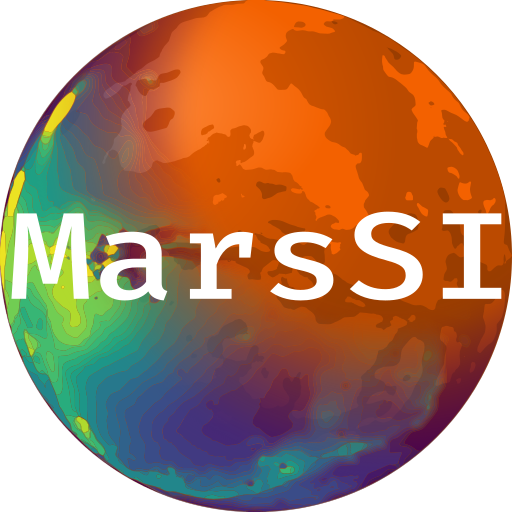Syntax highlighting of
HiRISE
{{https://upload.wikimedia.org/wikipedia/commons/2/2b/HiRISE_Flight_Structure.jpg||align="right",width="240"}}
The High Resolution Imaging Science Experiment (HiRISE) is a telescope working in orbit in the visible wavelengths and producing high resolution images resolving surface details down to 1-meter size (0.25 to 1.3 m/px). The images enable to study for instance the martian geomorphology but also seasonal surface changes.
<<TableOfContents()>>
== Data description ==
The HiRISE camera has 3 different color filtered CCDs: red (“RED”) from 570-830 nm, blue-green (“BG”) less than 580 nm and near-infrared (“IR”) greater than 790 nm. The high-resolution color images enable to distinguish the composition and albedo heterogeneities directly correlated to the geomorphology, complementary to the mineralogic results from the CRISM, HRSC, OMEGA and THEMIS instruments. The RED detectors provide a wide image used for geomorphologic analysis and for stereoanalysis, while the additional detectors are used to create false-color imaging of the central of the swath only (20% of the RED swath width).
Data file description:
* `PSP_005000_1000_RED.JP2` (grayscale mosaic of all RED-filter channels)
* `PSP_005000_1000_COLOR.JP2` (IR, RED, BG 3-color product over center 20% of the RED swath width)
Each JP2 image also has a PDS label (.lbl) providing useful information about the observation such as map projection and viewing information.
== Processing HIRISE data ==
=== CTX Imagery ===
The pipeline for the topographic mapping derived from HiRISE images uses both the USGS ISIS system (the ISIS 3 system) and the commercial stereogrammetric software SOCET SET. The DTMs have a 1-meter spatial resolution and 25 cm vertical precision. For more details about the process used to create HiRISE DTMs, see [[http://onlinelibrary.wiley.com/wol1/doi/10.1029/2007JE003000/full|Kirk, R.L. et al. (2008)]].
From the “Maps” tab, zoom-in on your region of interest, you can display the THEMIS mosaic for more precision, and then display the HiRISE layer. You get all HiRISE stamps that appear in blue. The stamps are regularly updated to take into account new data. You can use the “Select” button to choose the stamp you desire. You can choose several stamps by clicking several stamps, or by dragging your mouse to select adjacent stamps. You can also use the “Search” button for more options.
{{attachment:view_hirise_layer.png||width="800"}}
To add your desired stamps to your cart click on “Add” in the “Cart” window, and go to the “Workspace” tab. Your HiRISE image appears in the window “Data to process”. If not, you may already have processed it yourself, or someone else may have processed it, then it may already be in the “Data processed” window. If the image has not been processed, you will have to go through several steps:
1. Download the HiRISE EDR image (rawdata) to the MarsSI server by clicking on the EDR image and the “Process” button in the “Data to process” window. This will take a few minutes.
2. When the first step is done, you can create a calibrated RDR image: click on the proposed RDR image in the “Data to process” window and on the “Process” button. This will take another few minutes, depending on the length of the observation.
3. Project the image by processing the proposed MRDR image in the “Data to process” window. This will take more time than the previous processes, another few minutes.
When these different steps are done, the MRDR image is waiting for you in the “Data processed” window and you can copy it to your SFTP partition.
== References ==
* HiRISE instrument and data website: http://hirise.lpl.arizona.edu
* HiRISE DTM creation explanation: http://www.uahirise.org/dtm/about.php
* HiRISE instrument description paper: McEwen, A. et al. (2007). J. Geophys. Res., 112, E05S02, doi:10.1029/2005JE002605.
* HiRISE DTM description paper: Kirk, R.L. et al. (2008). J. Geophys. Res., 113, E00A24, doi:10.1029/2007JE003000.
